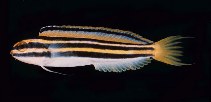
|
Meiacanthus lineatus (De Vis, 1884) Lined fangblenny |

|
|
photo by
Randall, J.E. |
| Family: | Blenniidae (Combtooth blennies), subfamily: Blenniinae | |||
| Max. size: | 9.5 cm TL (male/unsexed) | |||
| Environment: | reef-associated; marine | |||
| Distribution: | Western Pacific: known only from the Great Barrier Reef. | |||
| Diagnosis: | Dorsal spines (total): 4-4; Dorsal soft rays (total): 25-28; Anal spines: 2-2; Anal soft rays: 15-17. Caudal lobes in males elongate; upper 2/3 of head and body yellow with 3 black stripes of equal width to yellow interspaces; head and body below lowermost stripe white; yellow dorsal fin with submarginal black stripe edged in bluish white; yellow caudal fin (Ref. 27362). | |||
| Biology: | Oviparous. Eggs are demersal and adhesive (Ref. 205), and are attached to the substrate via a filamentous, adhesive pad or pedestal (Ref. 94114). Larvae are planktonic, often found in shallow, coastal waters (Ref. 94114). Mimicked by Petroscirtes fallax and by the young Scolopsis bilineatus. Poisonous canines provide considerable protection from predators. | |||
| IUCN Red List Status: | Least Concern (LC); Date assessed: 28 March 2009 Ref. (130435) | |||
| Threat to humans: | venomous | |||
| Country info: |
|
|||